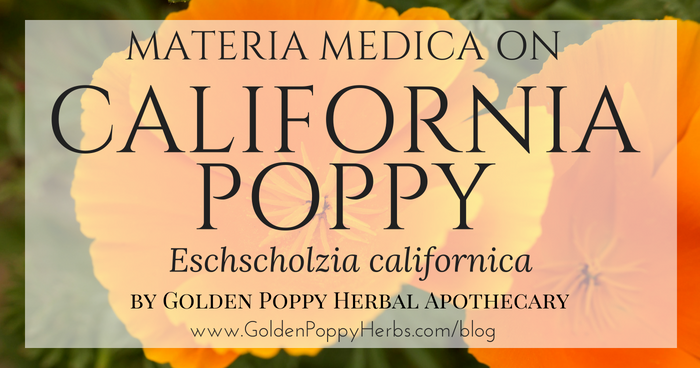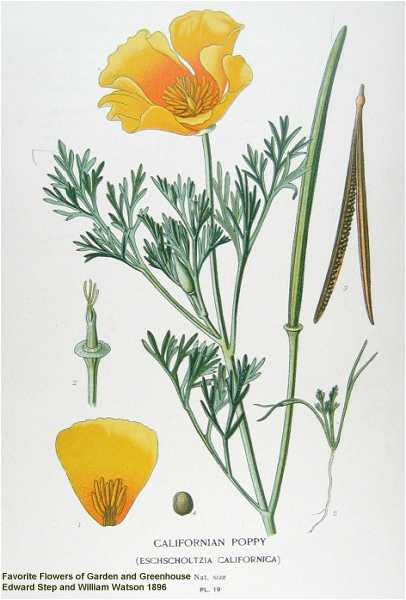 Unlike the large red or white Poppy, California poppies are the smaller golden poppies commonly grown as ornamental plants. They too have some of the same effects as their stronger cousins, but because they do not contain any opiates, they are considered to be the safer and less-controversial of the two plants to use. These poppies encourage the relaxation of the nervous and skeletal muscular system, making them an excellent addition to sleep and pain formulas. They are also good for anxiety, insomnia, restlessness, stress, and sometimes headaches. California poppy is used by Western herbal practitioners for sleep disorders, muscular tension, pain, and anxiety. In the same family as the opium poppy, California poppy demonstrates similar analgesic and anxiolytic applications, but without the narcotic or addictive properties (Mars, 2001). California poppy has been used both internally and externally as an analgesic to address pain of various types: headaches, migraines, and neuralgia (Tierra, 1998; Tierra, 1988), as well as muscular tension, muscle spasms, and backaches (Winston, 2005; Romm, 2009).
Unlike the large red or white Poppy, California poppies are the smaller golden poppies commonly grown as ornamental plants. They too have some of the same effects as their stronger cousins, but because they do not contain any opiates, they are considered to be the safer and less-controversial of the two plants to use. These poppies encourage the relaxation of the nervous and skeletal muscular system, making them an excellent addition to sleep and pain formulas. They are also good for anxiety, insomnia, restlessness, stress, and sometimes headaches. California poppy is used by Western herbal practitioners for sleep disorders, muscular tension, pain, and anxiety. In the same family as the opium poppy, California poppy demonstrates similar analgesic and anxiolytic applications, but without the narcotic or addictive properties (Mars, 2001). California poppy has been used both internally and externally as an analgesic to address pain of various types: headaches, migraines, and neuralgia (Tierra, 1998; Tierra, 1988), as well as muscular tension, muscle spasms, and backaches (Winston, 2005; Romm, 2009).
MATERIA MEDICA: CALIFORNIA POPPY

Latin Name: Eschscholzia californica
Family: Papaveraceae (Poppy Family)
Parts Used: Whole plant or just aerial portions for a perrenial grower
Distribution: California poppy is native to the western United States, from Baja Sur north to Washington state, and from the Pacific coastline east to parts of the Sonoran Desert and the Great Basin (Smith, 2010). California poppy is considered an invasive species in Tennessee (USDA NRCS, 2016).
Energetics: Cool, dry, bitter, yin
Actions: analgesic, anodyne, antispasmodic, hypnotic, nervine, sedative
Key Constituents: Isoquinoline alkaloids, including protopine, californidine, eschscholtzine, allocryptopine, sanguinarine, chelerythrine; flavone glycosides (rutin); and carotenoids (Skenderi, 2003).
Preparation & Dosing:
- Tincture: 15-30 drops of the tincture, 1:2. 45% *
- Infusion: Use 1 teaspoon dried aerial parts per cup boiling water, infuse 10 min, and take one cup at bedtime to aid with sleep.* 1-2 teaspoons of the herb steeped in 1 cup of boiling water.**
- Dosage information from *The Way of Herbs by Michael Tierra.
Uses:
- Anxiety
- Insomnia
- Stress
- Pain
- Restlessness
- Headaches
Cautions:
- Avoid in cases of depression
- Do not use during breastfeeding
- California poppy may have additive effects when combined with other herbal or prescription sedatives (Marciano, 2015), and could increase the risk of motor impairment or drowsiness when combined with alcohol (Natural Standard, 2016).
- Use caution with prescription drugs such as MAO inhibitors and benzodiazepines (Mars, 2001; Natural Standard, 2016).
- California poppy should best be avoided by those who are pregnant or trying to become pregnant, as the alkaloid cryptopine found in California poppy has been shown in animal studies to have a stimulating, oxytocic effect on the uterus (Smith, 2010; Skenderi, 2003).



